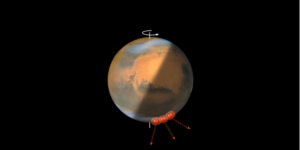A European Space Agency satellite has detected a mysterious glow coming from Mars. Measured in the visible spectrum with the NOMAD-UVIS instrument on board the European Space Agency (ESA) Trace Gas Orbiter (TGO) satellite, the unexpected glow emanates from the night side of Mars and was observed in the planet’s upper atmosphere.
A similar glow was witnessed by the same research team using a satellite orbiting Venus. Like that visible light signal, the researchers believed the mysterious glow coming from Mars resulted from oxygen interacting with the planet’s upper atmosphere. That’s mainly because they also saw a similar mysterious glow coming from Mars, only in the daytime.
“Back in 2020, we were already able to detect the presence of a green emission between 40 and 150 km in altitude, present during the Martian day,” explained Jean-Claude Gérard, a planetologist at the Laboratory for Planetary and Atmospheric Physics (LPAP) at the University of Liège (BE), where the research team was headquartered. “This was due to the dissociation of the CO2 molecule, the main constituent of the atmosphere, by ultraviolet solar radiation”.
However, the researchers soon discovered that this unexpected mysterious glow coming from Mars was originating from the nighttime side. They also figured out it was caused by something else entirely.
“This emission is due to the recombination of oxygen atoms created in the summer atmosphere and carried by the winds towards the high winter latitudes,” explained Lauriane Soret, a researcher at LPAP.
Once at higher altitudes, the atoms recombine with CO2 molecules when they come in contact. This reaction, the researcher explains, produces an oxygen molecule “in an excited state” that relaxes, causing it to emit light “in the visible range.”
Mysterious Glow Coming from Mars Could Provide Critical Evidence about the Planet’s Seasons
The researchers say they discovered the glow by reorienting the UVIS-NOMAD instrument on the ESA’s Mars Trace Gas Orbiter (TGO) satellite so it could scan the atmosphere on its edge. They quickly detected the light emissions, which appeared to be concentrated over the polar regions of the red planet. According to the announcement of the discovery, “the oxygen atoms converge in the downward branch of the gigantic trajectory from the opposite hemisphere.”

Now that they know what to look for, Soret says their study will be continued during the TGO mission, hoping it “will provide us with valuable information about the dynamics of the Martian upper atmosphere and its variations over the course of the Martian year.”
Another Mysterious Light Emission Spotted in the Ultraviolet Range
In their published research, which appears in the journal Nature Astronomy, the team says that along with the mysterious glow coming from Mars in the visible light range, they have also spotted a glow in the ultraviolet range. That glow, they believe, is not caused by oxygen but something else entirely.


“We have noticed that another ultraviolet emission due to the nitric oxide (NO) molecule is also observed by UVIS in the same regions,” said Soret. “Comparing the two emissions will enable us to refine the diagnosis and identify the processes involved.”
Fellow researcher Jean-Claude Gérard adds that these “unexpected and interesting” observations will also likely help guide future missions to the red planet. The researcher even points out that future missions could carry cameras to capture images of the glow for all to see.
“The intensity of the night glow in the polar regions is such that simple and relatively inexpensive instruments in Martian orbit could map and monitor atmospheric flows,” he concludes, noting that the glow is bright enough “to be observable during the polar night by future astronauts in orbit or from the Martian ground.”
Christopher Plain is a Science Fiction and Fantasy novelist and Head Science Writer at The Debrief. Follow and connect with him on X, learn about his books at plainfiction.com, or email him directly at [email protected].

Dr. Thomas Hughes is a UK-based scientist and science communicator who makes complex topics accessible to readers. His articles explore breakthroughs in various scientific disciplines, from space exploration to cutting-edge research.








